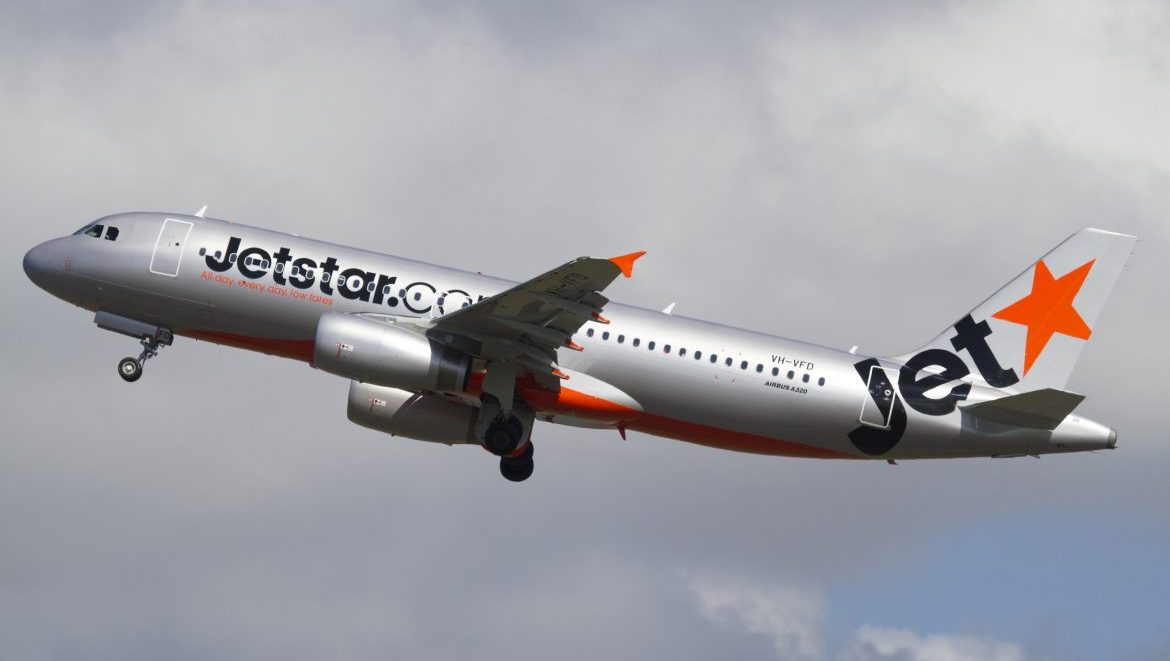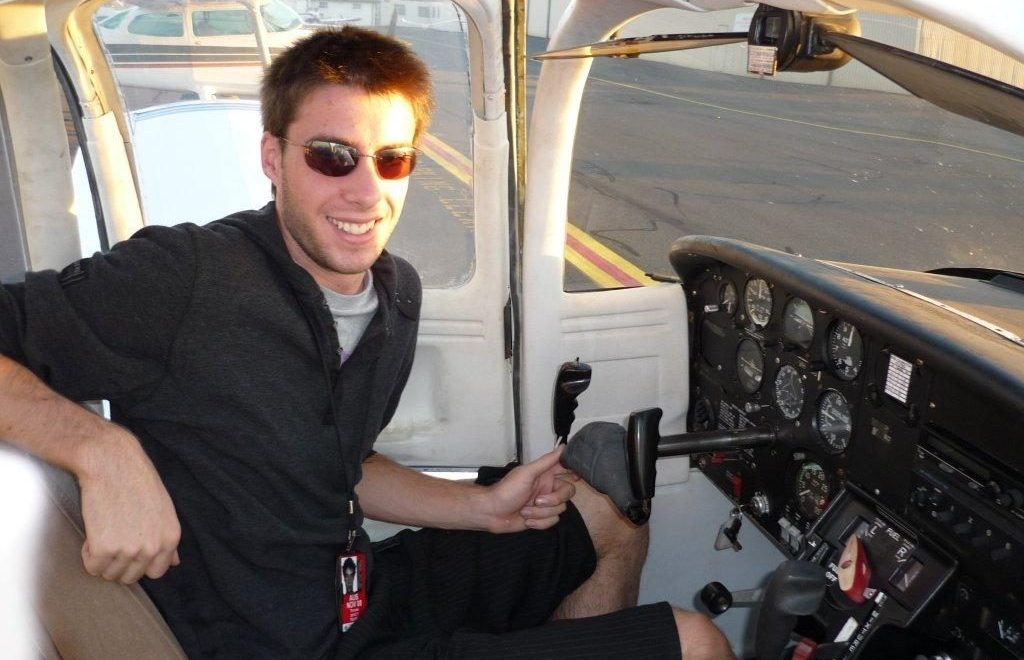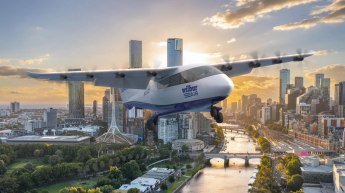To celebrate Father’s Day we’ve republished this feature article on a Jetstar father and son which first appeared in the January-February 2014 issue of Australian Aviation.
Jetstar’s Peter Wyatt has been a commercial airline pilot since 1979 and in 2013 was joined at the airline by his son, Tom who, like his father, now also flies the Airbus A320.
Twenty-five years separates the commencement of their careers, a quarter century marked by much tumult, technological advancement and cultural shift in the Australian airline industry.
Though not unprecedented, even at Jetstar, father-son pilots are still a rare phenomenon in this country. Australian Aviation spoke with both Peter and Tom Wyatt, ahead of their first joint flight as A320 aircrew in February.

Old school
Perth-based Peter Wyatt began flying for Ansett in 1979 as a first officer on the Fokker F27 Friendship, and stayed with the airline until its collapse in 2002. In that time, he progressed through the ranks, becoming a captain and training/check captain on the F27, Fokker 50, 737-200 and -300. In 1999, Captain Wyatt was seconded to Kendall Airlines to oversee the introduction of the Bombardier CRJ200, rising to senior check captain on the type.
After a brief stint in New Zealand as check and training captain on the 737‑300 for Jetconnect, he joined Jetstar Asia in 2005 as an A320 captain. He has since held the position of A320 training manager (as a training and check captain), pilot cadet manager and flight operations development manager for Perth, where he resides.
Despite the obvious rewards of a career in aviation, Peter Wyatt freely admits he applied no pressure to his son to pursue a similar career.
“I didn’t encourage or discourage him. I wanted him to make up his own mind. Aviation is either in the blood or it isn’t. I did have some trepidation – the industry wasn’t what it was, having been through pilot disputes and airline collapses. And I’ve realised that pilots have a narrow skill base and what I thought was a job for life is something I’m not so certain about. That said, I think aviation will roll on, and you pick yourself up and get on with it again.”
For his part, Tom Wyatt, then an early adolescent, was undeterred by the twin shocks of Ansett’s collapse and the September 11 terrorist attacks.
“I guess it proved to me that things….like world events can change the industry so quickly. I don’t think it made me second guess the career path I wanted to follow. It was still something I wanted to do.”
Having embarked upon his aviation career in 2009, Tom undertook a Bachelor of Aviation degree at Swinburne University. While studying, he completed flying training, earning his PPL in 2009, his CPL and Multi-Engine Command Instrument Rating (MECIR) in 2011. After applying for a Jetstar cadetship that year, he was accepted, and completed a multi-crew orientation course at Moorabbin in May 2012. He was then type rated on the A320 after a two-month course with CAE in the UK, before becoming ‘checked to line’ in September 2013.
Reflecting an increasingly common practice within the industry, Tom’s path to the right hand seat has involved a contracted training provider. This included hundreds of hours in a state-of-the-art simulator, psychometric testing and a solid grounding in cockpit resource management (CRM). This contrasts starkly with the experience of his father, who commenced flying in a much less congested sky following a training unprovided with high fidelity simulators.
“I went straight into as a first officer on the F27. It was a simple environment – we didn’t have security, you went to work, turned up on time, got into the aircraft and got going. As far as the training, the F27 wasn’t a simulator supported aircraft, so when I went on as an FO and did base training in the aircraft, flying the aircraft with a supervisor and check pilot. We used to go and fly a little Link Trainer to do IFR type training – the original Link Trainer that we used to fly still exists in the Ansett sim complex, as a museum piece! We used to close the little lid, sit in the darkness, and there was another pilot who’d be sitting outside and he’d have a two dimension plotter and he’d ask you to fly a DME homing – something that we don’t even do these days.”
Indeed it is the immense strides in high fidelity cockpit simulation that stands as one of the most (but, interestingly, not the most crucial) difference between the flight training experience of Peter and Tom Wyatt. Before sims were commonplace, proficiency was maintained by sending pilots aloft in actual aircraft though, mercifully, ones devoid of passengers.
“In lieu of sims, we’d go out and do a base check. One of the things that was quite exciting was going out in the actual aircraft and doing V1 cut (a simulated engine failure on takeoff). You wouldn’t shut down the engine but bring it back to a zero thrust. It was quite exciting, but, in retrospect, quite dangerous and probably for a good reason we do that in the sim.”
Summing up the differences simulators have made to the training of commercial airline pilots, Peter Wyatt points out that his son’s training in the A320 simulator is so faithful to the actual experience that “the first landing he did in an aircraft would have been with a load of passengers on board. There’s no base training. His first landing would have been on a revenue flight.”
Mirroring the magnitude of change between Peter Wyatt’s pilot training and his son’s was Tom’s experience of the contrast between the theory and practice of commercial flying. He explained:
“I did my first flight on April 11. It was Brisbane to Adelaide, and I was in Brisbane, doing my first 100 hours of training. As part of that, your first two flights you operate as Pilot Not Flying (PNF). It was a very different ball game coming out of the sim program, where it was constantly dealing with failures and things going wrong. And then stepping into an aircraft – from signing on, to getting your flight plan and briefing the cabin crew and walkaround, was a really big leap.
“I probably didn’t get into the swing of how things went from day to day for a couple of weeks. It really hit home as to what job I was doing on my third day when I operated as Pilot Flying. I was sitting in the right hand seat of the jet, thinking ‘I have to land it.’ So that’s what all the training prepares you for, to get to that point. It was one thing to do the training but to step in and do a line flight was another thing again.”
A320 – Keeping it in the family
Both Peter and Tom completed their A320 type rating overseas, in Toulouse and Gatwick, respectively. For those prospective Jetstar pilots, A320 conversion is done as part of Phase 2 of its Cadet Program. It is open to those with a CPL and MEICR, and those who have successfully completed the multi-crew and jet orientation course. Once completed, the cadet pilot earns his or her ATPL, and is authorised to act as pilot in command on a scheduled air carrier’s aircraft. As Tom explained “I think coming to the program, all cadets go straight onto the A320. We don’t fly the A321 until 12 months after check-to-line. It was a really good program and prepared me for Jetstar’s transition program.”
For Peter, then on the 737, conversion to the Airbus A320 represented a chance to see how the other half flew.
“The challenge was adjusting from Boeing to Airbus, but it was reasonably straightforward. It took 12 months, but I’m certainly an Airbus convert now. The things I like compared to the 737 are the bigger, quieter cockpit, the tray table, the ergonomics of sitting on the A320 flightdeck. I find it suits me better. But they’re both fantastic aircraft.”

CRM – The game changes
In 1979, the year Peter began flying, the NTSB issued its landmark recommendation to require CRM training for airline crews, in the wake of several significant crashes that had resulted from the catastrophic human error on the flightdeck.
And it is the wholesale adoption of the CRM philosophy that Peter Wyatt nominates as the greatest single change to the airline industry in his 25 years as a pilot. Describing his experience as a junior pilot, he recalled the steep ‘command gradient’ that existed between junior and senior pilots “In the early days, you sat in the right hand seat, and you were the FO. I’m not saying we carried the captain’s bag, but you’d sit over there and if, in a day’s flying, you got a sector, you were lucky. And when it came to meals, the captain would choose…”
In the wake of accidents such as the collision of two 747s at Tenerife and the crash of United Airlines 173 (in which a distracted crew failed to notice their aircraft’s fuel starvation, with fatal consequences), CRM was rolled out in what marked a defining cultural shift for commercial pilots.
“The big thing is that First Officers now have the power to speak up and that’s one of the biggest single changes I’ve seen. In fact, an FO would be struck across the knuckles for not speaking up. It was a change in the culture of two crew operations. I think…times have changed. The airlines had a huge military bias, that’s not felt so much, not that there’s anything wrong with that, but fighter pilots might have thought quite differently.”
As Peter pointed out, CRM is now embedded in the training of future airline pilots, specifically in the Multi Crew and Jet Orientation Course, which is mandatory for all Jetstar aircrew. This tuition aims to inculcate flightcrew with habits, reflexive responses and techniques for maximising cooperation in the cockpit. As Peter Wyatt put it:
“I guess when we learn as pilots in light aircraft we only operated as basically a single pilot. So, obviously when you do multi crew cooperation, it’s training a crew to coordinate, integrate standard operating procedure, the role of the pilot flying, the role of the PNF in the support role, and then it moves into the CRM concept. A lot of the training is based on problem solving, decision-making as a crew, and the appropriate communication between pilots.”

Off and running
As with many cadet pilots joining the airline, Tom Wyatt has his sights set on his next medium-term goal – flying one of Jetstar’s A330 widebodies. While the allure of the big Airbus is understandable, Peter Wyatt counsels patience to Tom and his contemporaries.
“When Tom does go for command, he might only fly six sectors a month on widebodies, compared to the 60 he will do on the narrowbodies doing short haul, with all those takeoffs, landings turnarounds. You need to get a lot of that under the belt before you contemplate a command. And it’s experience he won’t get on the widebodies. You just don’t get enough sectors in a month. One thing I’d say is spend as much time reading as much as you can while you’re an FO, be in no rush for command and just enjoy the journey.”
One particularly notable sector for Tom Wyatt was due to take place on February 14 2014 when he was scheduled to fly Sydney-Perth return with his father. The two are based on opposite sides of the country, so meetings are rare. In fact, Peter revealed that the first time he’d even seen his son in his pilot’s uniform was at a chance encounter in Jetstar’s Melbourne crew room.
No doubt Peter is effusively proud of the endeavour his son has displayed to ultimately lead him to the coveted right hand seat of a commercial airliner. Not that such sentimentalism has any place in the cockpit occupied by this father and son.
“I hope we get a landing each. We’ll be able to judge who’s better. That’s if I give him a landing, of course.”
This article originally appeared in the January/February 2014 edition of Australian Aviation magazine.
To read more stories like this, subscribe here. Digital editions of the magazine can be purchased on Zinio and Issuu, or in the Apple app store.
Remember to enter our 2018 Father’s Day Competition:
Treat the special man in your life to the gift of aviation this Father’s Day with a subscription to Australia’s premier aviation magazine – Australian Aviation Magazine. Plus he’ll go in the prize draw to win either:
1st Prize: Samsung Galaxy S9 + 2 x Avalon Airshow 2019 Gold Pass
2nd Prize: 2 x Avalon Airshow 2019 Gold Pass















Kevin Walsh
says:Peter taught me to fly 30 + years ago. My family will never forget the friendship shown by Peter on my first unrestricted flight from Lilydale airport in my Beechcraft Sierra.